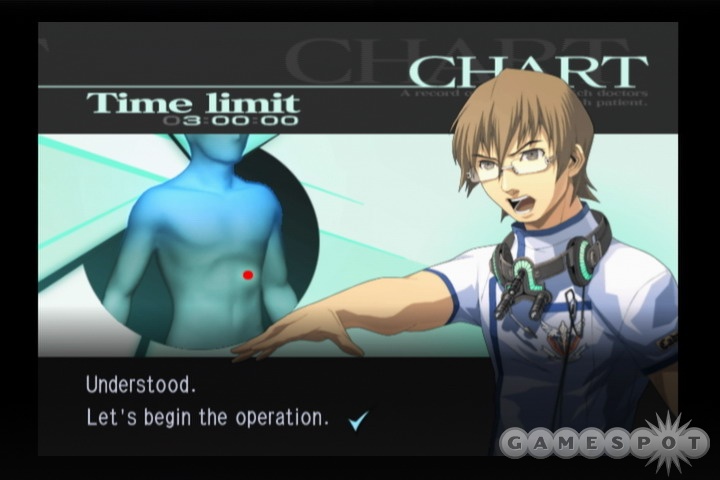

With a controller in each hand you will be able to manipulate more than a dozen different instruments on-screen in realistic ways such as injecting with syringes, making incisions with scalpels, removing tumours with tweezers ('pinching' by pressing the A and B buttons together) and bringing patients back to life with a shock from the defibrillator paddles (by moving both hands forward and pressing buttons on both controllers simultaneously).īy using two controllers, you can use one hand (the Nunchuk) to select instruments and the other (the Wii Remote) to wield them. In the DS version you used the touch screen and stylus to perform surgical procedures but in this Wii version you can get totally hands-on by using the motion sensitive Wii Remote and Nunchuk. In Trauma Center: Second Opinion you take the role of rookie doctor Derek Stiles - a young surgeon with the extraordinary 'Healing Touch' ability - as he is enlisted into the secret Caduceus organisation to combat a deadly new disease.
WII GAME TRAUMA CENTER SECOND OPINION SIMULATOR
The only changes made to the story involve Nozomi Weaver and the storyline following her Z-Missions.The hit Nintendo DS surgical simulator comes to Nintendo's new home console in this remake (or 'Wii-make') with vastly updated graphics, a second playable character, a new sixth chapter and new instruments to wield - this time with the Wii controllers.

Putting aside the fact that Second Opinion is a retelling of the DS version, the game is absolutely. The plot of Trauma Center: Second Opinion, is very similar to it's predecessor Trauma Center: Under The Knife. Now that the Wii launch is truly underway, is Trauma Center worth another dose Yeah, it is. The presence of an extra sixth chapter that takes place after the point the original DS game ended.One such new twist requires turning the Wii Remote in hand to rotate shattered bone fragments while piecing them back together. Weaver's missions, referred to as Z-Missions, are all-new and feature new twists on the gameplay not present in the DS game. The inclusion of a new side story that focuses on a new doctor, Nozomi Weaver.This new art direction has become the norm for the Trauma Center series. The game's art style was given a new direction, replacing the manga style of Under the Knife with more realistic character designs.The Nunchuck goes in your other hand and is only used for selecting instruments. The Wii-mote is held in your dominant hand and does the work of the game like moving and manipulating instruments. Just like the original used the stylus throughout most of the game, this game uses the Wii. Trauma Center: Second Opinion has similar gameplay to the DS game, but the Wii’s motion controls turn this into a new game. It is a remake, or as Atlus states, a 'Wii-make', to the hit Touch Generation game Trauma Center: Under the Knife for the Nintendo DS, though most of the game, including graphics and game mechanics have totally been redesigned to fit the console. Applying membranes to tumor extraction points no longer requires massaging the membrane after applying antibiotic gel. Trauma Center: Second Opinion () is a game for the Wii.The inclusion of a defibrillator, used by holding the Wii Remote and Nunchuk in a way that simulates the device's shock paddles.Multiple difficulty levels, replacing Under the Knife's single difficulty level.In remaking Under the Knife for the Wii, numerous changes were made to the game's presentation and gameplay. As the plot progresses, the player is faced with several strains of Gangliated Utrophin Immuno Latency Toxin, or GUILT, a terrorist made viral infection. Standard operations seen early in the game include the removal of tumors and mending severe lacerations.

The only major variation in tools is that instead of Derek using his hand to massage a flatlining heart, there is a defibrillator that makes use of the wii's motion controls.Īs in the original game, it is the player's job as Derek Stiles to save the lives of patients by performing operations.

The Wii Remote is used to carry out actions on screen such as making incisions, draining blood pools and suturing, while the analogue stick on the Nunchuck is used to easily switch between the available medical tools. The game uses the features of the Wii Remote and Nunchuck in place of the stylus-based gameplay of the DS game. The gameplay in Trauma Center: Second Opinion is very similar to it's predecessor Trauma Center: Under the Knife. New "Z-Missions" were added as well, along with a side narrative featuring Nozomi Weaver, a new character that like original protagonist Derek Stiles has the powers of the Healing Touch. The existing characters were all given a facelift using a new art style. A remake of Atlus's DS title Trauma Center: Under the Knife, the game adapts the original game's stylus-based gameplay to work with the Wii Remote and Nunchuk. Trauma Center: Second Opinion was released on November 19th, 2006 as a Wii launch title.


 0 kommentar(er)
0 kommentar(er)
